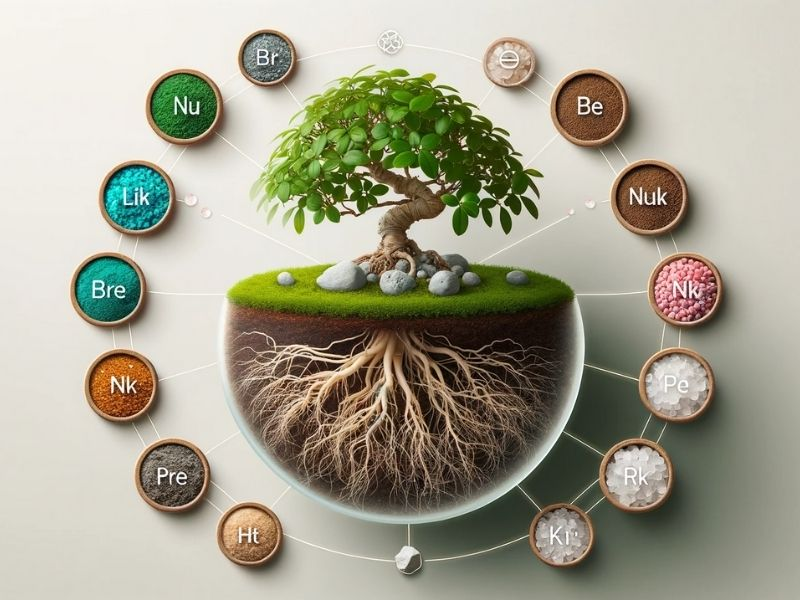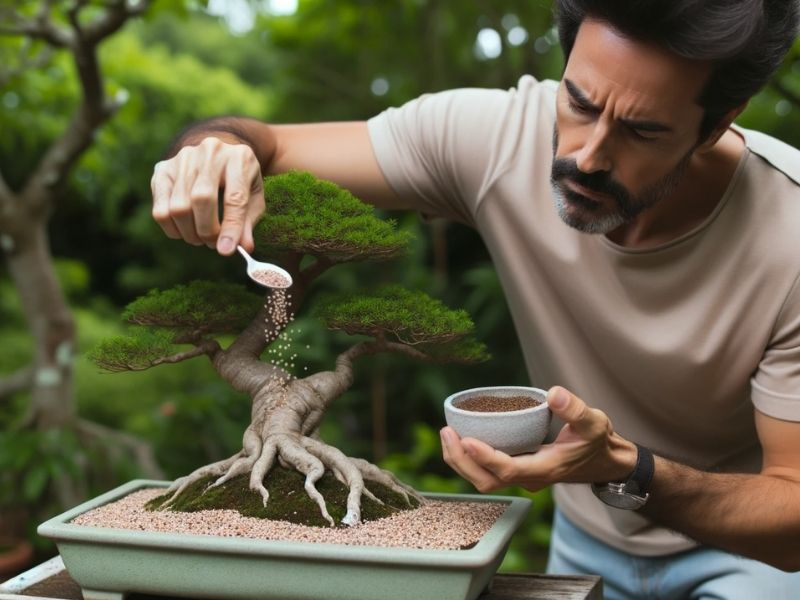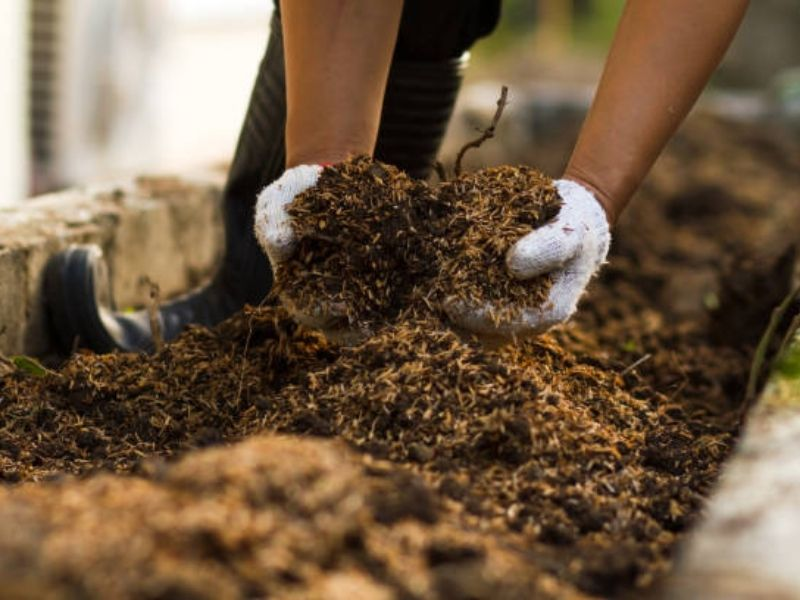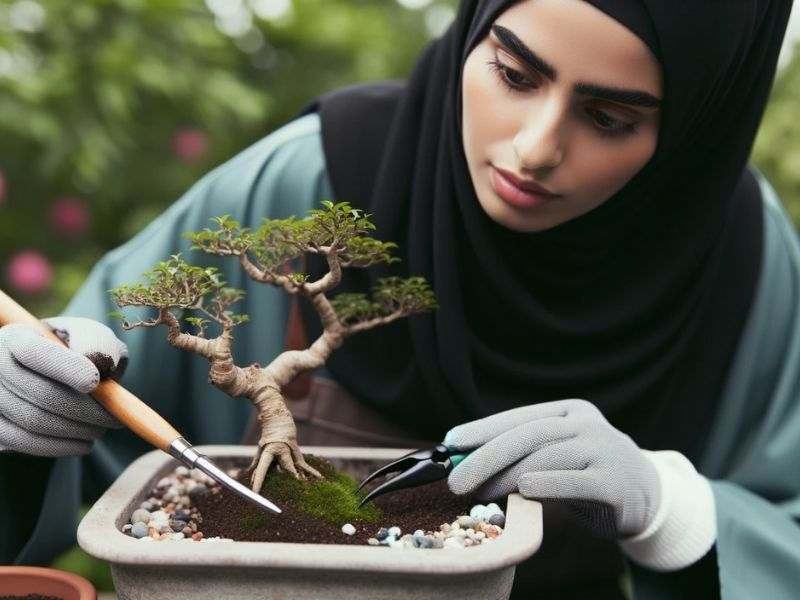Bonsai and plant nutrition hold paramount importance in the world of horticulture, especially when nurturing these miniature wonders. Bonsai trees, with their unique charm and beauty, demand a distinct approach to their nutritional needs compared to conventional plants.
This specialized care is not just about size, but it’s a deeper understanding of the intricacies involved in sustaining their health and vigor.
Unlike regular plant care, where generalized nutrition might suffice, bonsai trees benefit from a more tailored approach, ensuring they flourish and showcase their artistic appeal for years to come.
Bonsai’s Unique Nutritional Requirements

The diminutive stature of bonsai, often misinterpreted as a mere aesthetic choice, impacts its nutrient needs profoundly. The compact root system in the confined space of a bonsai pot has a limited capacity for nutrient absorption. This makes them susceptible to both nutrient deficiencies and nutrient overload.
For example, a regular-sized tree might easily absorb and process nutrients spread across a large area, but a bonsai requires a careful balance to ensure it gets just the right amount without causing a nutrient burn or deficit.
Moreover, due to the miniature nature of bonsai, the soil surface area available for nutrient absorption is much less, emphasizing the need for a more concentrated and precise feeding regimen.
A bonsai tree’s soil composition, be it bonsai soils or a specific soil mix, further impacts how effectively these trees can extract essential nutrients.
Essential Plant Nutrients And Their Impact On Bonsai Health

Every plant, regardless of size or species, relies on a combination of essential nutrients to thrive. These nutrients, often found in the soil and absorbed through the roots, play a pivotal role in various physiological and biochemical processes of the plant. For bonsai trees, these nutrients are the building blocks that determine their health, vigor, and aesthetic appeal.
There are two main categories of essential plant nutrients:
While macronutrients like nitrogen, phosphorus, and potassium are required in larger quantities, micronutrients like iron, zinc, and manganese are needed in trace amounts.
Nitrogen (N)
Vital for plant growth and promotes healthy foliage. It’s responsible for the vibrant green color of leaves and stimulates new shoot development. However, when considering bonsai trees, a high nitrogen fertilizer might lead to excessively fast growth, which isn’t always desirable in bonsai cultivation.
Phosphorus (P)
Aids in root development, flower, and fruit production. For bonsai enthusiasts, a robust root system is crucial, especially after root pruning sessions. Phosphorus ensures that the bonsai tree’s roots regenerate effectively and absorb nutrients efficiently.
Potassium (K)
Plays a multifaceted role, aiding in protein synthesis, regulating water flow within the plant, and enhancing resistance to diseases. A bonsai tree fortified with adequate potassium will showcase vibrant foliage and increased resilience to environmental stresses.
In the realm of bonsai and plant nutrition, the significance of these nutrients highlights the concept of a balanced fertilizer as crucial in bonsai care. A balanced fertilizer ensures an appropriate ratio of nitrogen, phosphorus, and potassium, often represented as N-P-K on fertilizer packaging.
Bonsai cultivators must be discerning when choosing a fertilizer, ensuring it offers the right N-P-K ratio tailored to the specific growth phase and needs of their bonsai tree.
Choosing The Right Fertilizer: Organic Vs. Inorganic

In the realm of bonsai cultivation, choosing the appropriate fertilizer is akin to selecting the right nourishment for an athlete. The right balance can propel the tree to its peak health, while a misstep can hinder its growth and vitality.
To make an informed decision, understanding the advantages and limitations of both organic and inorganic fertilizers is essential.
Organic Fertilizers

Derived from natural sources like animal manure, compost, or bone meal, organic fertilizers release nutrients slowly, ensuring a consistent feed for the bonsai.
Pros:
- Sustainable: Organic fertilizers are environment-friendly and renewable.
- Improved Soil Structure: They enhance the soil’s texture, aiding in moisture retention and aeration.
- Safe: Reduced risk of fertilizer burn or over-fertilization.
Cons
- Slow Release: Nutrients are released over time, which might not be ideal for immediate deficiencies.
- Variable Nutrient Ratio: Exact nutrient composition can be inconsistent.
- Odor: Some organic fertilizers might have a strong smell.
Inorganic Fertilizers

Often synthesized chemically, inorganic fertilizers provide an immediate boost of specific nutrients to the plant.
Pros:
- Immediate Effect: Fast-acting, addressing nutrient deficiencies swiftly.
- Consistent: Nutrient ratios are precise, allowing for targeted fertilization.
- Versatile: Available in varied formulations for different growth stages.
Cons
- Potential Harm: Overuse can lead to fertilizer burn or harm beneficial soil microbes.
- Short-term: They might not improve long-term soil health.
- Environmental Concerns: Some can contribute to water pollution if used excessively.
Liquid Vs. Solid Fertilizer Forms
Both liquid and solid fertilizers have their place in bonsai care. Liquid fertilizers are diluted in water and provide an instant nutrient boost, ideal for addressing immediate deficiencies or foliar feeding. Solid fertilizers, on the other hand, tend to release nutrients more slowly, providing a steady feed over an extended period.
Deciphering Fertilizer Packaging
The key to successful fertilization lies in understanding the product at hand. Bonsai cultivators should pay attention to the N-P-K ratio on the packaging, which indicates the percentage of nitrogen, phosphorus, and potassium. Furthermore, instructions regarding “how much fertilizer” to use and the recommended application frequency are paramount to avoid over or under-fertilizing.
Effective Fertilizing Techniques
Achieving a flourishing bonsai isn’t just about selecting the right fertilizer; it’s also about employing effective application methods. Ensuring that your bonsai receives optimal nutrition without causing harm is an art in itself, requiring a blend of observation, knowledge, and technique.
The Concept Of Foliar Feeding
In the context of bonsai and plant nutrition, foliar feeding involves applying a diluted liquid fertilizer solution directly to a plant’s leaves. Plants can absorb essential nutrients through their leaves, offering a rapid response to nutrient deficiencies. For bonsai trees, foliar feeding can be especially beneficial during the active growth phase, ensuring they receive immediate nourishment.
Benefits:
- Quick Absorption: Direct leaf application means faster nutrient uptake.
- Targeted Approach: Can address specific nutrient deficiencies promptly.
- Supplementary: Acts as a complement to root feeding, ensuring comprehensive nutrition.
However, it’s essential to use a diluted solution and avoid overdoing it to prevent potential leaf burn or damage.
Recognizing Signs Of Nutrient Deficiencies
A keen eye can discern signs of nutrient imbalance in bonsai trees, allowing for timely interventions.
- Nitrogen Deficiency: Older leaves turn yellow or pale green.
- Phosphorus Deficiency: Leaves might take on a dark green or purple hue, with stunted growth.
- Potassium Deficiency: Brown or yellow leaf edges and weak stems.
Addressing these signs involves analyzing the possible cause – whether it’s the soil mix, water quality, or fertilizer type – and then modifying the fertilization strategy accordingly.
Strategies To Avoid Common Pitfalls
Fertilizer Burn: One of the most common issues bonsai enthusiasts face is fertilizer burn, which arises from excessive fertilization. Symptoms include scorched leaf tips or a white crust on the soil surface.
Prevention strategies include:
- Gradual Introduction: Start with a diluted fertilizer solution and gradually increase the concentration.
- Regular Flushing: Periodically water the bonsai thoroughly, allowing excess salts to drain away.
- Consistent Monitoring: Regularly inspect the soil surface for salt build-up and adjust the fertilization schedule if needed.
Delving Into Bonsai Soil Health

The soil in which a bonsai tree grows isn’t just a placeholder; it’s an environment, a lifeline, and a support system. For bonsai, with their miniature stature and specialized needs, the soil is of paramount importance, playing a significant role in ensuring optimal plant growth and vigor.
The Significance Of Soil Mix And Soil Composition
Bonsai trees, given their unique cultivation techniques and size constraints, require a soil mix that caters to their specific needs.
The ideal bonsai soil composition should:
- Facilitate good drainage, ensuring that excess water can easily escape, preventing root rot.
- Retain sufficient moisture to provide the roots with a steady supply of water between watering sessions.
- Offer adequate aeration, allowing the roots to breathe and access essential gasses like oxygen and carbon dioxide.
Unlike typical garden soil, which may be dense and clayey, bonsai soil is often a blend of various components like akadama (a type of clay granule), sand, organic compost, and even volcanic grit.
Each of these components plays a role in maintaining the soil’s structural integrity and nutrient balance.
The Role Of Bonsai-Specific Soils
Bonsai-specific soils are formulated to cater to the unique requirements of these miniature trees.
These soil mixes often prioritize:
- Optimal pH levels, ensuring that the soil environment is neither too acidic nor too alkaline, which can affect nutrient uptake.
- Beneficial microbes that aid in nutrient breakdown and root health.
- Structural stability to support the tree and allow for robust root development.
Investing in a quality bonsai soil mix can make a marked difference in the tree’s growth, health, and resistance to diseases.
Root Pruning, Root Growth, And Soil Health
In the sphere of bonsai and plant nutrition, root pruning is a fundamental aspect of bonsai cultivation. By trimming back the roots, cultivators ensure that the tree remains in its miniature form and doesn’t outgrow its pot. However, root pruning also stimulates healthy root growth, leading to a denser and more efficient root system.
But there’s a catch. After each root pruning session, the bonsai tree needs a rejuvenated soil environment to support its newly emerging roots. The fresh soil provides the necessary nutrients, ensuring that the roots regenerate effectively and anchor the tree securely.
Moreover, as the roots grow and expand, they draw nutrients from the soil, emphasizing the need for a well-balanced and nutrient-rich soil mix. It’s a cycle of growth, pruning, and rejuvenation, with soil health at its core.
Navigating Bonsai Growth Cycles For Fertilization
Bonsai cultivation is akin to a symphony, with each phase, from budding to dormancy, playing a critical note. Understanding the rhythm of these growth cycles is essential, especially when it comes to fertilization.
Nourishing a bonsai isn’t just about the what—the type of fertilizer—but also about the when—the timing in relation to the tree’s growth cycle.
The Relevance Of The Growing Season In Bonsai Care
The growing season is a pivotal period for bonsai trees. It’s when they’re actively putting out new growth, be it leaves, branches, or roots. This phase demands energy, and consequently, nutrients.
Recognizing the onset of the growing season is key:
- Spring Surge: The onset of spring, with warmer temperatures and longer daylight hours, kickstarts the bonsai’s growth. New leaves might appear, and the tree’s overall metabolism accelerates.
- Summer Sustain: As summer sets in, the tree continues its growth but at a steadier pace. While the energy demands remain high, they’re more consistent.
During these periods, the bonsai’s demand for nutrients like nitrogen, phosphorus, and potassium peaks. A balanced fertilizer, preferably a high nitrogen fertilizer during the early stages of spring, aids in supporting this rapid growth.
Adjusting Fertilizer Use During Active Growth Vs. Dormant Periods
The life of a bonsai isn’t always bustling. Post the active growth seasons, as autumn and winter set in, the tree gradually transitions into a dormant phase.
- Autumn Adaptation: As temperatures drop, the bonsai tree slows down. While there’s still some growth, it’s markedly reduced. This period requires a shift in fertilization, moving from high-nitrogen to a low nitrogen fertilizer, emphasizing phosphorus and potassium for root development and to fortify the tree for the impending winter.
- Winter Rest: Come winter, the tree is in a state of rest. It’s conserving energy, and its nutritional demands drop significantly. In colder climates, especially for outdoor bonsais, it’s advisable to reduce or even withhold fertilization, ensuring the tree isn’t prompted into untimely growth.
Incorporating an understanding of these cycles into your bonsai care routine ensures that the tree receives the right nutrients at the right time. It’s about harmonizing with the tree’s natural rhythms, providing support when needed, and allowing it space when it’s time to rest. This nuanced approach not only ensures a healthy bonsai but also a flourishing one, season after season.
Prioritize Your Bonsai’s Health
In the intricate dance of bonsai cultivation, every step, from the artful trimming to the calculated watering, speaks volumes about your commitment. Yet, at the core of this delicate ballet is the tree’s health, heavily reliant on informed nutrition. Understanding the nuances of bonsai and plant nutrition is paramount, turning your bonsai from a mere ornamental piece to a thriving testament of nature paired with dedicated care.
So, as you marvel at your bonsai, recognize that its external beauty is deeply rooted in its internal health. It’s more than just feeding; it’s about nurturing with knowledge. Embrace the journey of bonsai cultivation with a heart that prioritizes its well-being, ensuring your bonsai stands as a beacon of both nature’s splendor and your attentive care.





0 Comments